2015 Audi RS 7 Vs 2015 Jaguar XFR-S

Two years before sitting down to write this, I stood inside the L.A. Auto Show gazing at the Jaguar XFR-S and hoping for a chance to drive one.
Well that day finally arrived in early fall when a gap opened in the Jaguar press fleet. I leapt at the chance.
European Bad Boys on Wheels
In case you forgot – it’s been a while – the XFR-S uses Jag’s 5.0-liter supercharged V8 to send 550 hp and 502 lb-ft of torque to its rear wheels via an eight-speed automatic. Jaguar says the XFR-S needs 4.4 seconds to reach 60 MPH, but that was totally out of mind during my first few minutes with the car.
Get the Flash Player to see this player.
Instead I punched the exhaust button and flipped the switch into “dynamic” mode for maximum fun. Having driven the F-Type V8 S earlier this year, I expected to hear an absolutely hellacious exhaust note, but I didn’t.
The blown V8 makes glorious noises and you can hear them from the driver seat, but it sounds more like the car is mumbling curse words under its breath than barking drill sergeant-style orders like the F-Type. Or at least that’s the case from inside because the roar is anything but subtle.
Without wasting time, I made tracks to the AutoGuide.com test circuit to meet our esteemed features editor, Sami Haj-Assaad, who was waiting with a car that he believed could run circles around the Jaguar. The cheeky bastard brought an Audi RS 7.
Audacious Audi
This Audi is blisteringly quick; it’s the most powerful RS product ever to emigrate from Germany to the U.S.
It is stunning to see in person, it rockets to 60 MPH in 3.7 seconds and it boasts a baffling output of 560 hp with 516 lb-ft of torque to boot. That power is distributed to each of its four wheels via Audi’s rear-biased quattro all-wheel drive system. In short, the RS 7 feels quicker than shit through a goose.
And that’s all without mentioning how it sounds. If the Jag’s engine roars like a lion, Audi’s 4.0-liter twin-turbo V8 grunts like a wild boar. It has a bass rich rumble that snorts between upshifts at wide-open throttle that is nothing short of addictive to hear from the cockpit, let alone an unsuspecting curb.
It also costs roughly $30,000 more than the maliciously tuned XF, or roughly enough to cover the average American country club’s initiation fee several times over. Sami and I were determined to find out if we could justify the jump in price over the Jag, so we hit the race track.
Trackable Toughness
The RS7 can barrel down a straightaway like a police dog pursuing a pickpocket, but it can turn, too. Its all-wheel drive system removes most of the guesswork in high-speed cornering and transforms hot lapping a hi-po German sedan into hilarious good fun. That is, until you get the tire bill. Both of these cars are porky, but the Audi weighs 4,475 lbs and that means it likes to understeer. The quattro system does a damn fine job of mitigating that, but it can also chew through front tires quickly.
Audi only sells the RS7 with an eight-speed automatic that has the same gearing as the A7 except for a more aggressive final drive ratio. Of course the car will shift for itself, but you can also specify gear changes with paddle shifters sitting behind the steering wheel.
The RS7 is also especially endearing because of how customizable it is. You name it and there’s a personalization setting to control it through the infotainment system. Throttle response, shift timing, how loud the exhaust is and even variable belt tension – to name a few – can all be tweaked to your heart’s content
Given all that, it’s hard not to look at the RS 7 like a fire breathing piece of menacing technology on wheels.
Meanwhile, the XFR-S seems like a bedazzled version of the blunt clubs we used to kill small food as Neanderthals. It’s lighter, but only barely at 4,380 lbs and the platform it uses dates back to the Jaguar X-Type or worse still, the Ford Thunderbird.
Where the Audi has space-age systems like cylinder deactivation to save fuel, the Jag’s 5.0-liter V8 treats gasoline much like Barney Gumble does Duff beer, but it’s hard to give a damn.
Compare Specs
| Vehicle | 2015 Jaguar XFR-S | Advantage | 2015 Audi RS7 |
|---|---|---|---|
| Engine | 5.0L Supercharged V8 | 4.0L twin turbo V8 | |
| Transmission | Eight-speed auto | Eight-speed auto | |
| HP | 550 @ 6,500 RPM | Audi | 560 HP @ 5,700 - 6,600 RPM |
| Torque | 502 lb-ft from 2,500 rpm to 5,500 rpm | Audi | 516 lb-ft from 1,750 to 5,500 RPM |
| 0-60 | 4.4 seconds | Audi | 3.7 seconds |
| Curb weight | 4,380 lbs | Jaguar | 4,475 lbs |
| Base price | $99,895 | Jaguar | $107,425 |
| Price as tested | $104,450 | Jaguar | $134,575 |
Yes, the platform is old, but no that doesn’t mean it isn’t a track capable vehicle. There’s a silver lining to how old the XF is because just like all other Jaguars save the upcoming XE, this car uses hydraulic power steering and offers more a communicative connection between car and driver than the RS7 can.
The front tires are half an inch wider in the XFR-S than the XFR and the rear rubber gains a full inch, measuring 295 millimeters from sidewall to sidewall. By stepping up to the XFR-S, you also get springs at the front and rear that are 40 percent stiffer and that all boils down to a car that doesn’t shy away from road courses.
Tricky to Manage at the Limit
Trouble is, it’s really tough to dance around the limit in a car that is this heavy and has that much power. I have to admit that I came too hot into a corner more than once and found myself spinning out. It takes a ginger foot, patient control and an experienced driver to tickle the tail end out without sliding into an uncontrolled spin.
At least you can get an 18-way adjustable driver seat that is adjustable enough to hug someone as skinny as me.
Even Dave Pratte, our resident hot shoe, found himself at opposite lock while cornering more than once while he recorded the hot laps for this story. Depending on how you view that, the XFR-S can be a blast or the sort of car that might make you poop your pants. Thankfully I fall into the former category.
But speaking of track performance, you probably won’t be surprised to learn that the Audi was able to turn a quicker lap. It did the deed in 1:20.562 compared to the Jaguar at 122.160 and managed 1.17 peak cornering G’s versus 1.11 for the XFR-S. But things weren’t entirely one-sided because the Jaguar’s brakes actually pulled harder despite being fixed to the lighter car.
The Verdict
Sami argues that the hot lap data is final and while it’s tough to argue with hard numbers, I’m not so sure. The British car costs $104,450 including delivery and with optional equipment like the massive rear wing. Meanwhile, the Audi Sami drove stickers at $134,575.
It’s true that the RS7 is more practical. Fitted with winter tires it could be a year-round daily driver, it has more cargo room and it’s more efficient. On top of all that, it’s also quicker around a race track, but I’m not convinced that the sum of those margins is $30,000.
2015 Audi RS7, 2015 Jaguar XFR-S
LOVE IT
- Crazy acceleration
- AWD stability
- Many customizable options
- Engine sounds angry
- Steering feel
- Jaguar sex appeal
LEAVE IT
- Price
- Old platform
- Difficult to drive at the limit

Luke is an energetic automotive journalist who spends his time covering industry news and crawling the internet for the latest breaking story. When he isn't in the office, Luke can be found obsessively browsing used car listings, drinking scotch at his favorite bar and dreaming of what to drive next, though the list grows a lot faster than his bank account. He's always on <A title="@lukevandezande on Twitter" href="http://twitter.com/lukevandezande">Twitter</A> looking for a good car conversation. Find Luke on <A title="@lukevandezande on Twitter" href="http://twitter.com/lukevandezande">Twitter</A> and <A title="Luke on Google+" href="http://plus.google.com/112531385961538774338?rel=author">Google+</A>.
More by Luke Vandezande



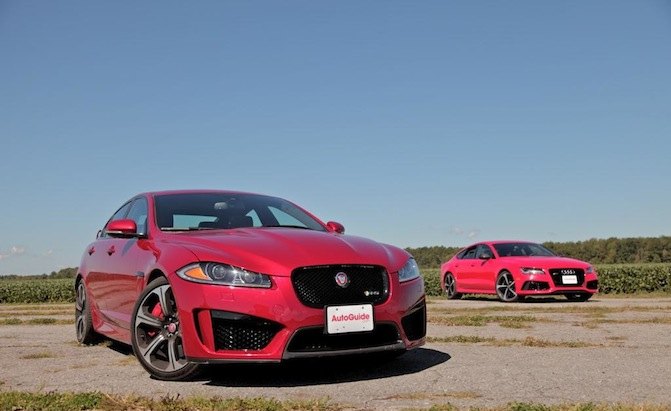














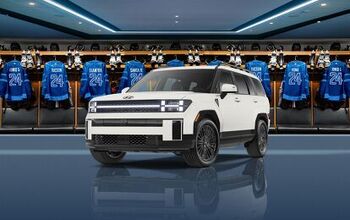

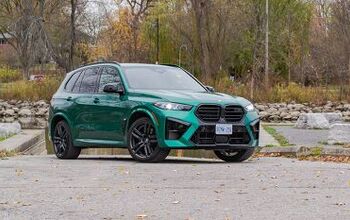
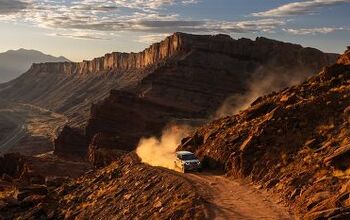




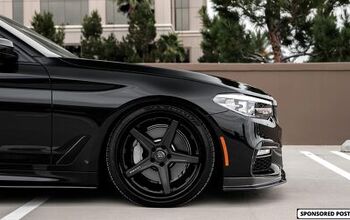


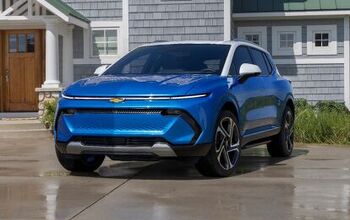
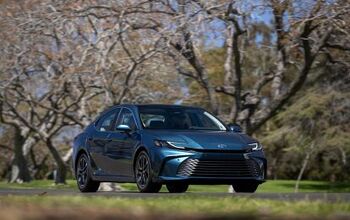

Comments
Join the conversation
That Jag is an ancient piece of crap. It's like two BMW generations old. And it was obviously slow.
Yes, the RS7 was fast, but it wasn't as fast as the RS5 you guys tested despite being significantly more powerful. Why is that? http://www.autoguide.com/auto-news/2014/12/fastest-lap-times-at-the-autoguide-test-track.html